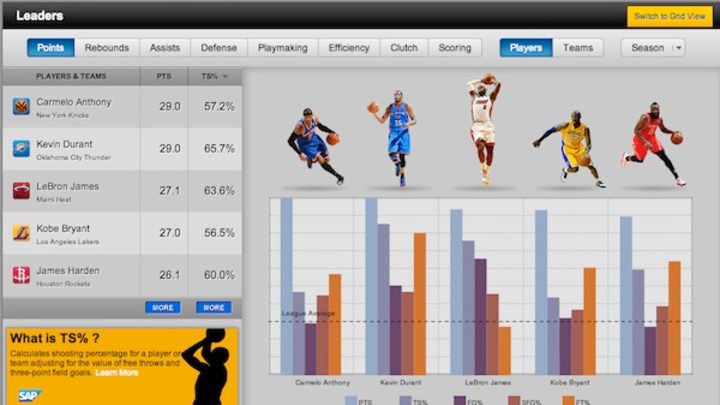Show and tell with the NBA's new advanced stats tool

The NBA's new stats tool allows access to an amazing amount of previously exclusive information. (NBA.com)

By Rob Mahoney
The NBA's very own information age has dawned in the last half-decade or so -- a pivotal stretch that offered unprecedented public resources to fans, provided that they knew where to look and which questions to ask. Twitter allowed fans to keep tabs on their favorite stars and shifted the nature of player-fan interaction into real time. Democratized video resources made it easier than ever to dig back into the tape of a particular game or go behind the scenes. And the explosion of publicly available "advanced stats" has given the pro game a new level of clarity, driven by the urge to better understand the NBA through as objective a lens as possible.
Any regular reader of The Point Forward likely understands the pertinence of that statistical frontier, as this space is regularly filled with analysis informed by pace-adjusted stats, specific lineup data and next-level player performance metrics. Websites such as Basketball-Reference.com and Hoopdata have supplied some of that information, but much of it comes from a media-only statistical resource provided by the NBA. Behind the pearly gates of the NBA's Media Central exists a wealth of information compacted and sorted into a comprehensive database, kept exclusive because of the technological hurdles of making such a massive resource available to a broader audience.
Well, those hurdles have now been cleared. Thanks to a partnership with SAP (and the invaluable HANA platform), the NBA has created a shiny, new portal for all of that previously exclusive data. You can dive deep into the performance of a player or team with just a few clicks, and learn about the most widely used advanced stats along the way thanks to an intuitive design with a clear focus on education. The goal isn't just to cater to the basketball diehards, but to get the basketball public at large up to speed regarding the best evaluative stats available. It's an incredibly inclusive platform put together by the most relevant party possible. This isn't me, Ben Golliver, Zach Lowe or Kevin Pelton telling you to pay attention to true shooting percentage -- this is the NBA itself, which has made that measure available (and defined) along with so, so much more.
If you're still not sold, I'd implore you to visit the site and poke around for yourself. If even that doesn't pique your interest, then just stop to consider everything that this portal has to offer:
• More accurate stats. The measures included in the standard box score are useful but aren't nearly as telling as some of the more refined measures available today. Rather than dwell on rebounds per game, you can check out the leaders in rebound percentage, which weighs the number of rebounds collected against the available opportunities for a board. Instead of relying on field goal percentage, you can examine a player's effective field goal percentage, which takes into account the added bonus of making a three-pointer. Rather than use points per game allowed to evaluate a team's defensive play, you can look at its Defensive Rating -- a refinement of the same concept that also accounts for pace of play. There are plenty of simple, flawed stats out there to rely on if you're so inclined, but why not spin the wheels on some new concepts with an added layer of value?
• An infinitely customizable data set. Sort and filter to your heart's delight. If you're keen on finding out which starting sophomore centers averaged the most points per 36 minutes in January road losses to the Charlotte Bobcats in 2004, then have at it. Or if you're a bit more practical -- say you'd like to suss out the best defensive teams over the last 20 games this season -- then that works, too.
• Lineup data. Judging overall performance on a team level can often be too general, while evaluating performance on a player-specific level (especially when it comes to on/off measures) can sometimes prove too noisy. Thus the lineup makes for a happy medium, as one can look at a five-man combination to learn more about how well that group plays as a unit, how a certain coach likes to build his lineups or what kinds of complementary parts fit best with a particular superstar.
• Detailed shot charting. Every player and team can have their shots charted by performance or tendency, in part because of the NBA's incredibly detailed shot location data. In addition to figuring out which players shoot most accurately on corner threes, you can plot out individual shooting performance in a more visual form. For example, here's a look at Carmelo Anthony's shots this season, zoned for shooting effectiveness with individual attempts plotted:

• Clutch performance statistics. Trust me when I say that all the data in the world probably still won't convince certain fans that Player X is anything but a "choker," but the NBA's new stats tool can at least lend some semblance of fact to an area of basketball conversation that has for too long leaned on anecdotal impression. Toggle a handful of clutch variables (time remaining in the game, size of the lead/deficit, etc.), and see how many different ways you can make Kevin Durant and Kyrie Irving rate as the best clutch performers in the league this season.
• Historical box scores. You can dig up a digital box score of any game in NBA history. Remember when Michael Jordan shot 3-of-18 from the field but the Bulls still beat the Knicks in Game 3 of the 1993 Eastern Conference finals?
Perspective.
